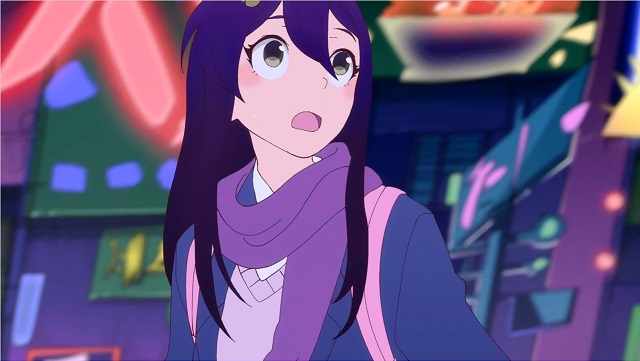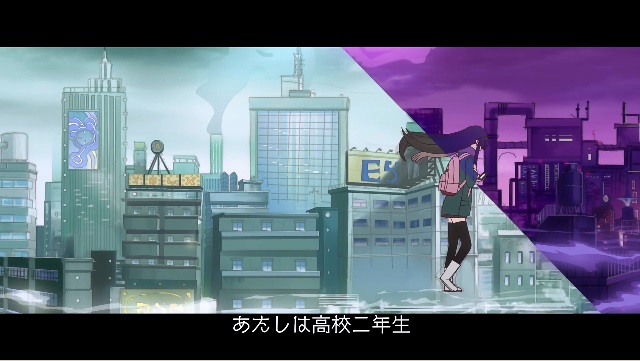How do you represent your protagonist moving from her mundane everyday world into an alternate reality? To Be Heroine does it by shifting languages.
To Be Heroine is an anime series created by the Chinese animation studio Haoliners. Haoliners its start doing subcontracting work for Japanese anime studios, but which has long since started doing its own shows as well, most of which weren’t very good. To Be Heroine is the spinoff of one of the exceptions, 2016’s To Be Hero, which had a core of new, young talent doing the animation for it. That show was a sci-fi comedy, whereas the new series is more of a isekai fantasy series, with the protagonist crossing over into a strange fantasy city. Isekai or trapped in fantasyland stories are omnipresent in modern day anime, but To Be Heroine does a couple of things different. First, instead of being transported to some standard medievaloid world, our heroine instead is transported to a warped version of her home city. Second, to underscore the transition, she goes from speaking Chinese to Japanese.

As usual in this sort of story, we first get a glimpse of Futaba’s everyday life, while she ruminates on making choices and sometimes having to accept not having any choice, while all the while she prepares to go out and gets dressed. The colouring and lightning is all fairly drab, fitting the rainy day it’s set in. Futaba herself too is a bit drab, clothed in shades of black and grey, her hair a realistic shade of black with even the green of the duvet on the left being a bit flat. The same goes for the other people seen in this sequence. Her parents are clearly older, aged, her classmates like herself look like actual teenagers.

The moment the door closes behind her and she steps out into an alternate reality her hair colour turns purple, her eyes become big and round and her voice becomes cuter and Japanese. The colour and lightning pop, her design is rounder and cuter and in general, everything looks more “anime”. So there’s both a visual and auditory disconnect between the muted, realistic, Chinese speaking mundane world and the cute, colourful, Japanese speaking fantasyland. The contradiction between drab mundane and colourful fantasy is obligatory for most isekai stories, but going so far as to switch language is unique to this series, only possible because we got a Chinese studio doing a series for the Japanese market. And then of course there’s the international market watching it subtitled in English (or your local language). It’s a clever use of language as signifier, but you got to wonder how a Chinese audience will like seeing the boring real world represented by their own language… Or that you can instantly become cute when you speak Japanese!

Setting aside that sort of consideration, what impressed me was the consistency with which the language scheme was kept. Chinese for the real world, including in Futaba’s flashbacks in the fantasy realm, Japanese when she’s talking to people there. And as you can see, the contrast in animation, colouring and lightning between the two worlds is kept consistent as well. Here Futaba literally steps out from her flashback back into the fantasy city.
To be honest, despite the praise it got from sakuga nerds, To Be Hero was too crude for me personally, so I never watched it beyond the first episode. To Be Heroine, its successor, looks to have both the incredible animation and a much better story and setting. If it can keep up the quality of this episode, it will be one of the best series of this season.
No Comments